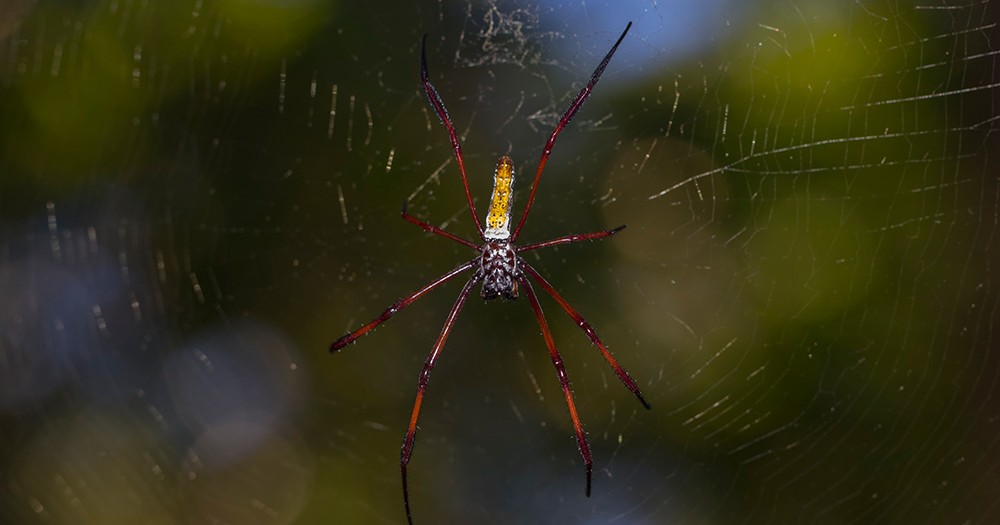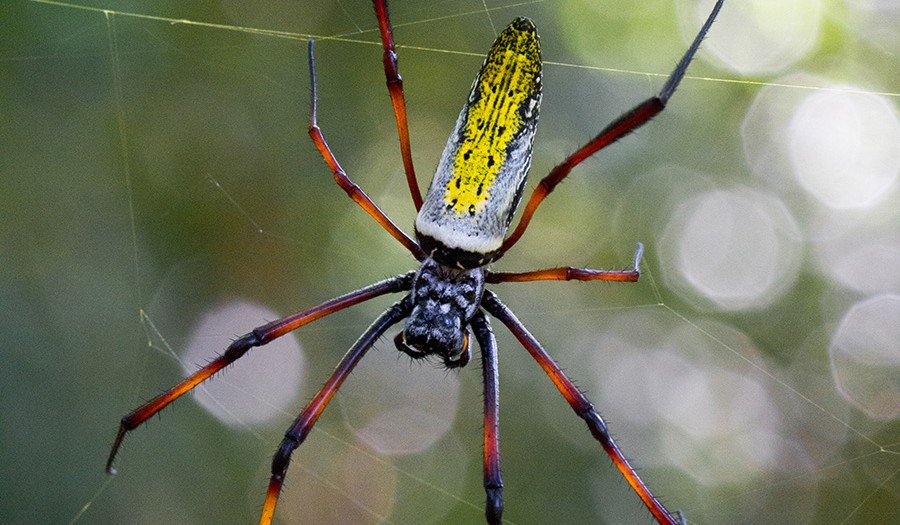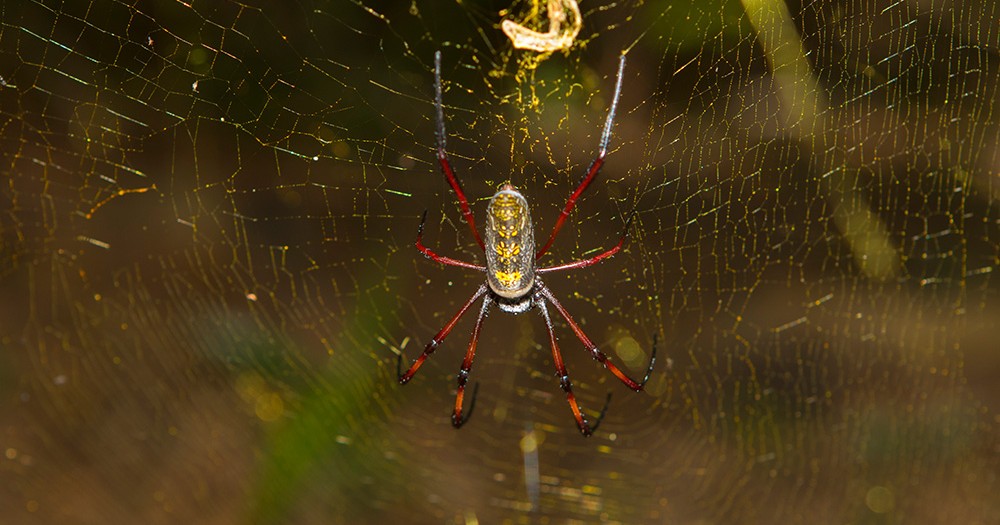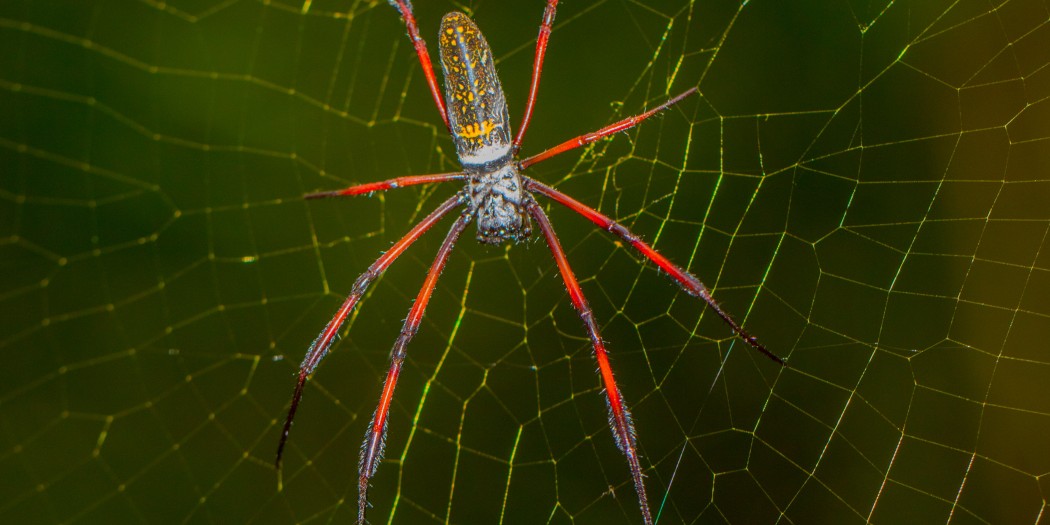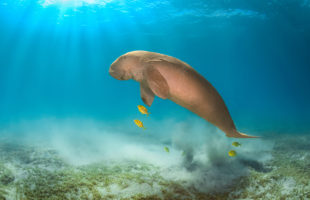Most travelers are more frightened by the sight of a spider, but the Red-Legged Golden Orb-Web Spider (Trichonephila inaurata madagascariensis) can teach some people otherwise. The female, including her legs, is as big as a human hand, the body is black with a golden-yellow, white-grey lined stripe on the back, the legs are broadly striped in black and red. The warning color is intended to prevent potential predators from eating the silk spider. Nevertheless, it is often food for birds and larger reptiles.

However, the name of the Golden Orb-Web Spider already indicates its most significant feature: Their nets are famous worldwide for their impressive size and stability. In the sun some threads also glow golden, which also led to the name of the spider. Scientists assume that the golden color attracts insects, i.e. potential prey, but can also serve to camouflage the net.
Every web is renewed daily or every few days in parts – so the Golden Orb-Web Spider is actually constantly busy with repair work. The parts to be removed are simply eaten by the female and by means of the spinning glands a new piece of net is spun in the same place. In the center is a small, very finely woven web (the so-called hub) in which the spider itself sits upside down. Around it, a framework of spiral threads is first drawn, between whose threads the sticky, golden-reflecting catching threads (the so-called catching spirals) are later woven. The entire net can grow up to two meters in size and is suspended on support threads between trees. From time to time in Madagascar, you can see whole collections of hundreds of silk spiders in webs woven between electricity or telegraph poles. In keeping with her huge nets, the generic name, Nephila, comes from ancient Greek and means “she loves to spin”.
The life of a Golden Orb-Web Spider begins as a so-called spiderling hatching from its cocoon. He and his siblings are still tiny, barely as big as a pinhead. Soon after their second molting, the small female silk spiders build their first web. Everything that fits into the net is eaten – from fruit flies to butterflies. The Golden Orb-Web Spider spider produces a nerve poison with which it immobilizes its prey by biting and then spins it in and eats it later. However, the poison is completely harmless to humans. In addition, Golden Orb-Web Spider is rather quiet and peaceful.
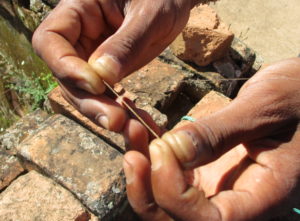
After five moultings the male is ready for mating. However, it looks very different from its female counterpart: It’s tiny, his body measures a mere 5 mm. The male waits in a corner of its partner’s huge network for the sexual maturity of her, which needs six more molts – and then for a good opportunity. This is usually the case when the Golden Orb-Web Spider female is busy with the feed intake or is currently molding. Otherwise, it can easily happen that the little male literally becomes the food for his beloved.
If it is not eaten, the life of the male of the Golden Orb-Web Spider is nevertheless already over after six months. The female lives about twice as long to lay her eggs and thus care for the next generation of silk spiders. The eggs are woven into a cocoon and glued to a tree trunk or under a leaf at night. After about one month, new spiderlings hatch but remain in their cocoon for two or three days until the first molting. About 100 to 500 spiderlings sit in each. Only after the second molting, after three to four weeks, the many young spiderlings disperse and a new generation begins to explore the Madagascan dry forest.

Incidentally, in some places in Madagascar, threads are woven from the old cocoons, from which scarves and scarves are made. The production of garments from the spun threads themselves is much more complex and expensive, which is why there are only three textiles woven from Madagascan spider silk worldwide: A canopy, presented at the 1900 World Exhibition in Paris, and a golden scarf made in 2004 by two designers from almost one million spider threads. In 2012, the two of them made up their minds again and established a huge golden cape. Unfortunately, the 1900 canopy has disappeared today.
- Video of the golden spider silk cape
Interview | England 2012 | Victoria and Albert Museum | London - Video of a molting female silk spider
 MADAMAGAZINE Your Magazine about Madagascar
MADAMAGAZINE Your Magazine about Madagascar
